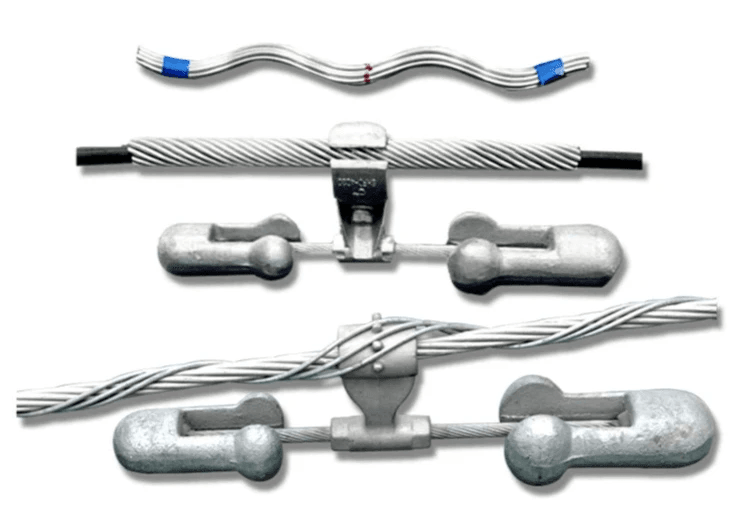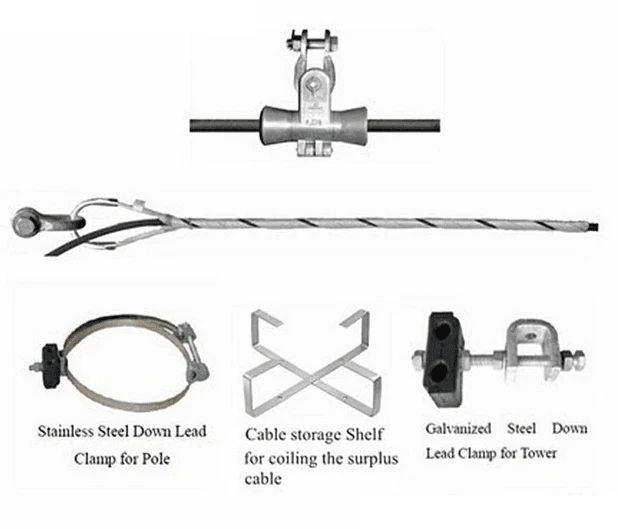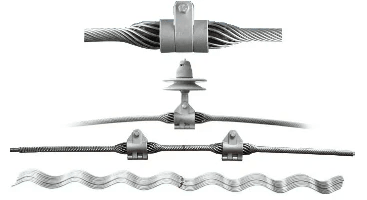Introduction

Guy wires might not be the most glamorous topic, but they play a crucial role in our infrastructure. From supporting communication towers to stabilizing power lines, understanding guy wires and their importance is essential for anyone involved in construction or engineering. They are silent heroes, quietly ensuring that structures remain upright against the forces of nature.
Understanding Guy Wires and Their Importance
So, what is the function of a guy wire? Essentially, these tensioned cables provide stability to tall structures by anchoring them to the ground or other support systems. Without guy wires, many of our towering constructions would be at risk of toppling over due to wind or other environmental stresses.
The Evolution of Guy Wire Technology
The technology behind guy wires has evolved significantly over the years. Initially crafted from natural fibers like hemp, modern guy wires are made from durable materials such as steel and synthetic composites that offer enhanced strength and longevity. This evolution has led to more efficient designs and better performance in various applications, ensuring that whether you're using a simple guy wire kit or intricate configurations, you can rely on their stability.
Common Misconceptions About Guy Wires
One common question is: Why do they call it a guy wire? The term guy actually originates from the French word guie, meaning to guide. Additionally, many people confuse guy wires with guide wires; however, while both serve important functions in stabilization, they differ significantly in application and design—it's crucial to know if you're looking for guy wires or guide wires for your project!
What is a Guy Wire?

Guy wires are essential components in the world of structural support, acting as tensioned cables that stabilize various structures, from telecommunications towers to utility poles. These wires provide the necessary support to ensure that vertical structures remain upright and withstand environmental forces such as wind and snow. In essence, a guy wire is like the unsung hero of construction, quietly holding everything together while often going unnoticed.
Definition and Basic Functionality
A guy wire is a tensioned cable used to add stability to structures by anchoring them at an angle to the ground. The primary function of a guy wire is to counteract lateral forces that could cause a structure to topple or sway. By distributing these forces across multiple points, guy wires help maintain the integrity and safety of tall structures, ensuring they can endure harsh weather conditions without compromising their stability.
Types of Guy Wires and Their Uses
There are several types of guy wires available, each designed for specific applications based on their material composition and tensile strength. Common materials include steel, which offers high durability for heavy-duty applications; synthetic fibers like nylon or polyester for lighter loads; and even fiberglass for specialized uses in certain environments. Depending on their application—be it telecommunications towers, radio masts, or construction scaffolding—different types of guy wires are chosen to meet specific load requirements and environmental conditions.
Why Do They Call It a Guy Wire?
The term guy wire has an interesting origin that sparks curiosity: why do they call it a guy wire? The word guy comes from the French term guie, meaning to guide, which reflects its role in guiding structural stability rather than implying any human connection. This distinction often leads people to wonder if it's actually “guy” or “guide” wire; however, rest assured that when you hear “guy wire,” it’s all about providing essential support where needed most.
The Role of Hardware in Structuring Guy Wires

When it comes to the stability and functionality of guy wires, hardware plays a pivotal role. The right components ensure that these essential supports can withstand environmental stresses while maintaining structural integrity. Understanding the hardware involved is crucial for anyone asking, What is the function of a guy wire? and wanting to maximize its potential.
Essential Hardware Components
To effectively support a structure, several essential hardware components are required for guy wires. These include anchors, tensioners, and various fittings that connect the guy wire to the main structure or pole. Each piece serves a unique purpose; for instance, anchors secure the guy wire in place while tensioners adjust how taut the wire is, ensuring optimal performance and stability.
Additionally, when considering whether to use a guy wire or guide wire, it's important to note that both rely heavily on quality hardware for their respective functions. The choice between them may come down to specific applications or preferences in setup—underscoring why selecting appropriate hardware is paramount. Ultimately, understanding these components will help you avoid common mistakes during installation and maintenance.
Spark Fittings: Leaders in Guy Wire Hardware
Among various manufacturers of guy wire hardware, Spark Fittings stands out as a leader in innovation and reliability. Their products are designed specifically with durability in mind and offer an extensive range of fittings tailored for different applications involving guy wires. When pondering Why do they call it a guy wire?, one might also consider how high-quality fittings contribute significantly to their effectiveness.
Spark's offerings include everything from turnbuckles to clevises that enhance the overall performance of your setup. Choosing reputable brands like Spark ensures you have reliable connections that can handle tension without compromising safety or functionality. This attention to detail can make all the difference when determining whether you need a comprehensive Guy Wire Kit or individual components.
How Hardware Complements Guy Wire Performance
The synergy between hardware and guy wires cannot be overstated; they work together seamlessly to provide optimal support for structures like towers or masts. Properly chosen hardware not only enhances performance but also extends the life span of your installation by reducing wear over time—something every installer should keep in mind when setting up their system.
Moreover, understanding what differentiates guys from stay wires can aid in selecting compatible hardware options tailored specifically for your project needs. While both serve stabilizing roles, their applications differ slightly based on design considerations which reflect on how well each performs under varying conditions with respect to their respective setups—hence reinforcing why quality matters so much!
In conclusion, investing time into understanding essential hardware components will pay off significantly when installing or maintaining your system involving guy wires—after all, proper equipment leads directly to better outcomes!
Installing Guy Wires: Best Practices

Installing guy wires may seem like a straightforward task, but it requires careful planning and execution to ensure safety and effectiveness. Understanding the nuances of guy wire installation can save you time and headaches down the line. Let’s dive into the best practices for installing these essential support structures.
Preparing for Installation
Before you start, gather all necessary tools and materials for your guy wire installation. This includes your guy wire kit, anchors, hardware components, and safety gear. Ensure that you have a clear understanding of the environment where you'll be working—this means checking for obstacles that could interfere with your installation or affect the function of your guy wires.
Next, it's important to assess the specific requirements of your project. Ask yourself: What is the function of a guy wire in this context? Are you securing a tower, antenna, or another structure? Knowing this will guide you in choosing the right type of anchors and hardware components from your guy wire kit.
Lastly, familiarize yourself with local regulations regarding installations involving towers or other structures supported by guy wires. Compliance with these rules is crucial not only for safety but also to avoid any potential legal issues later on.
Step-by-Step Installation Guide
Now that you're prepared, let's break down the step-by-step installation process for your guy wires. Start by marking out where each anchor will be placed; this typically involves measuring distances based on manufacturer specifications or project requirements. Proper spacing is critical—too close together can lead to instability while too far apart may not provide adequate support.
Once you've marked your spots, begin installing the anchors according to their type—whether they are driven into soil or secured with concrete bases. After ensuring that each anchor is firmly in place, it's time to attach the actual guy wires using appropriate hardware fittings from your kit.
With everything connected securely, adjust each wire's tension carefully to ensure optimal performance without putting undue stress on any component. Remember: proper tensioning directly impacts how well your system functions—so take it slow!
Common Mistakes and How to Avoid Them
Even seasoned professionals can make mistakes when installing guy wires—so being aware of common pitfalls can help prevent mishaps! One frequent error is improper tensioning; if a wire is too loose or too tight, it won't perform its intended function effectively. Always double-check tensions after installation before considering it complete.
Another mistake involves neglecting environmental factors such as wind load or soil conditions when determining anchor placement and spacing between supports. Always consider these elements as they significantly influence what type of anchors you should use and how far apart they need to be positioned.
Finally, don't underestimate the importance of using quality hardware components from reputable manufacturers like Spark Fittings in your installations! Using subpar materials might save money initially but could lead to larger issues—and costs—in terms of maintenance down the road.
Anchors: The Silent Heroes of Guy Wires

When discussing guy wires, it's easy to overlook the unsung heroes that keep them taut and effective: anchors. These vital components are the foundation upon which guy wires rely for stability and support. Without robust anchors, even the best-designed guy wire systems would struggle to perform their essential functions.
Different Types of Anchors
Anchors come in various shapes and sizes, each designed to suit specific applications and soil conditions. Common types include deadman anchors, which use buried materials for stability, and screw anchors that twist into the ground for a secure hold. Understanding these options is crucial when assembling your guy wire kit; choosing the right anchor can significantly impact the overall performance of your guy wire setup.
What is the Function of a Guy Wire?
So, what is the function of a guy wire? Simply put, a guy wire stabilizes structures like towers or masts by providing lateral support against forces such as wind or gravity. This prevents swaying or tipping, ensuring that your installation remains upright and functional—an essential consideration whether you're dealing with communication towers or simple flagpoles.
How Anchors Affect Overall Performance
The effectiveness of any guy wire system hinges on its anchors; they essentially determine how well your setup can withstand external forces. A poorly chosen anchor can lead to slippage or failure during high winds or storms, rendering your guy wires ineffective. Therefore, selecting high-quality anchors tailored to your specific needs is paramount—after all, you wouldn’t want to be left wondering why it’s called a guy wire when it fails at an inopportune moment!
Guy Wire Kits: A Comprehensive Solution

When it comes to securing structures like towers, masts, and other vertical installations, a guy wire kit can be your best ally. These kits are designed to provide all the necessary components for effective installation and maintenance of guy wires. But what exactly should you look for in a comprehensive guy wire kit?
What to Include in a Guy Wire Kit
A well-rounded guy wire kit typically includes high-quality guy wires themselves, which are essential for stability. Additionally, you'll want hardware components such as anchors, tensioners, and fittings that facilitate secure connections and adjustments. Don't forget about protective gear like sleeves or clamps; these items enhance the longevity of your guy wires by preventing wear and tear.
Benefits of Using a Guy Wire Kit
Using a complete guy wire kit streamlines the installation process significantly; everything you need is bundled together! This not only saves you time but also ensures compatibility between components—no more mismatched parts or last-minute trips to the hardware store. Furthermore, having all necessary materials in one place reduces costs compared to purchasing items separately.
Guy Wires or Guide Wires: Which to Choose?
You might be wondering if there’s any difference between guy wires and guide wires—after all, they sound similar! While both serve important functions in providing support, the primary role of a guy wire is to stabilize structures against lateral forces. So when you're faced with the question Is it guy or guide wire? remember that if you're looking for stability and support for your tower or mast setup, go with a sturdy guy wire.
Conclusion

As we wrap up our exploration of guy wires, it’s clear that these unassuming cables play a critical role in ensuring the stability and safety of various structures. Understanding their importance helps us appreciate not just their functionality but also the engineering behind them. So, whether you're erecting a tower or setting up a tent, recognizing how vital guy wires are can make all the difference.
Recognizing the Importance of Guy Wires
Guy wires are often overlooked but are essential in providing structural support for everything from radio towers to flagpoles. They act as stabilizers, counteracting forces such as wind and tension that could otherwise topple these structures. This leads us to ponder: why is it called a guy wire? The term guy is believed to derive from the French word guie, meaning a guide or support, which perfectly encapsulates their purpose.
Choosing the Right Guy Wire Solutions
When selecting guy wire solutions, it's crucial to consider factors such as material strength and environmental conditions. You might wonder about the difference between guy wire and stay wire; while both serve similar functions in stabilization, stay wires typically provide vertical support while guy wires work at an angle. Whether you opt for pre-packaged options like a Guy Wire Kit or custom solutions, ensuring you have the right specifications will enhance performance and durability.
Final Thoughts on Guy Wire Applications
In conclusion, understanding what is the function of a guy wire extends beyond mere installation; it's about recognizing its role in safety and stability across multiple applications. If you're still debating between guy wires or guide wires for your project, remember that choosing correctly can prevent costly mistakes down the line. So next time you see one of these cables at work, you'll know exactly why they're indispensable!

